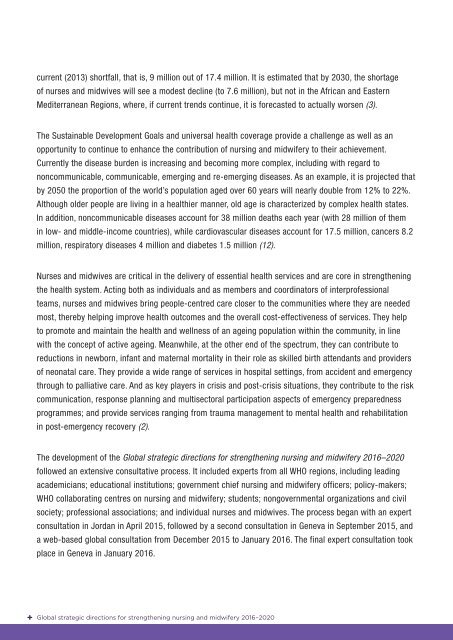Global strategic directions for strengthening nursing and midwifery 2016–2020
OMS%20ENFERMERIA
OMS%20ENFERMERIA
You also want an ePaper? Increase the reach of your titles
YUMPU automatically turns print PDFs into web optimized ePapers that Google loves.
current (2013) shortfall, that is, 9 million out of 17.4 million. It is estimated that by 2030, the shortage<br />
of nurses <strong>and</strong> midwives will see a modest decline (to 7.6 million), but not in the African <strong>and</strong> Eastern<br />
Mediterranean Regions, where, if current trends continue, it is <strong>for</strong>ecasted to actually worsen (3).<br />
The Sustainable Development Goals <strong>and</strong> universal health coverage provide a challenge as well as an<br />
opportunity to continue to enhance the contribution of <strong>nursing</strong> <strong>and</strong> <strong>midwifery</strong> to their achievement.<br />
Currently the disease burden is increasing <strong>and</strong> becoming more complex, including with regard to<br />
noncommunicable, communicable, emerging <strong>and</strong> re-emerging diseases. As an example, it is projected that<br />
by 2050 the proportion of the world’s population aged over 60 years will nearly double from 12% to 22%.<br />
Although older people are living in a healthier manner, old age is characterized by complex health states.<br />
In addition, noncommunicable diseases account <strong>for</strong> 38 million deaths each year (with 28 million of them<br />
in low- <strong>and</strong> middle-income countries), while cardiovascular diseases account <strong>for</strong> 17.5 million, cancers 8.2<br />
million, respiratory diseases 4 million <strong>and</strong> diabetes 1.5 million (12).<br />
Nurses <strong>and</strong> midwives are critical in the delivery of essential health services <strong>and</strong> are core in <strong>strengthening</strong><br />
the health system. Acting both as individuals <strong>and</strong> as members <strong>and</strong> coordinators of interprofessional<br />
teams, nurses <strong>and</strong> midwives bring people-centred care closer to the communities where they are needed<br />
most, thereby helping improve health outcomes <strong>and</strong> the overall cost-effectiveness of services. They help<br />
to promote <strong>and</strong> maintain the health <strong>and</strong> wellness of an ageing population within the community, in line<br />
with the concept of active ageing. Meanwhile, at the other end of the spectrum, they can contribute to<br />
reductions in newborn, infant <strong>and</strong> maternal mortality in their role as skilled birth attendants <strong>and</strong> providers<br />
of neonatal care. They provide a wide range of services in hospital settings, from accident <strong>and</strong> emergency<br />
through to palliative care. And as key players in crisis <strong>and</strong> post-crisis situations, they contribute to the risk<br />
communication, response planning <strong>and</strong> multisectoral participation aspects of emergency preparedness<br />
programmes; <strong>and</strong> provide services ranging from trauma management to mental health <strong>and</strong> rehabilitation<br />
in post-emergency recovery (2).<br />
The development of the <strong>Global</strong> <strong>strategic</strong> <strong>directions</strong> <strong>for</strong> <strong>strengthening</strong> <strong>nursing</strong> <strong>and</strong> <strong>midwifery</strong> <strong>2016–2020</strong><br />
followed an extensive consultative process. It included experts from all WHO regions, including leading<br />
academicians; educational institutions; government chief <strong>nursing</strong> <strong>and</strong> <strong>midwifery</strong> officers; policy-makers;<br />
WHO collaborating centres on <strong>nursing</strong> <strong>and</strong> <strong>midwifery</strong>; students; nongovernmental organizations <strong>and</strong> civil<br />
society; professional associations; <strong>and</strong> individual nurses <strong>and</strong> midwives. The process began with an expert<br />
consultation in Jordan in April 2015, followed by a second consultation in Geneva in September 2015, <strong>and</strong><br />
a web-based global consultation from December 2015 to January 2016. The final expert consultation took<br />
place in Geneva in January 2016.<br />
<strong>Global</strong> <strong>strategic</strong> <strong>directions</strong> <strong>for</strong> <strong>strengthening</strong> <strong>nursing</strong> <strong>and</strong> <strong>midwifery</strong> <strong>2016–2020</strong><br />
16061_<strong>Global</strong> Strategic Midwifery.indd 6 04/05/16 14:06


